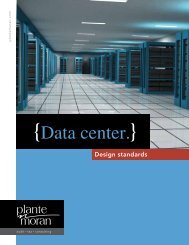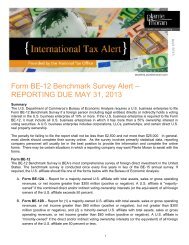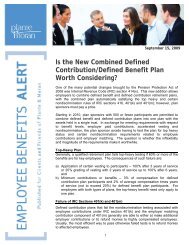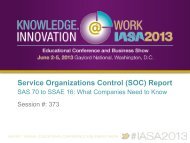summary report of the plastics processing industry - Plante Moran
summary report of the plastics processing industry - Plante Moran
summary report of the plastics processing industry - Plante Moran
- No tags were found...
Create successful ePaper yourself
Turn your PDF publications into a flip-book with our unique Google optimized e-Paper software.
NORTH AMERICAN PLASTICS INDUSTRY STUDY | 2011INTRODUCTIONWe are pleased to present <strong>the</strong> fall 2011 edition <strong>of</strong> <strong>the</strong> NorthAmerican Plastics Industry Study Summary Report. This <strong>report</strong>summarizes data from 86 completed surveys collected throughSeptember 30, 2011, representing more than 142 facilitiesin a broad array <strong>of</strong> processes from throughout North America(most <strong>of</strong> <strong>the</strong> participants are based in <strong>the</strong> United States).We have focused our survey efforts in 2011 on post-recessionperformance (after June 2009). As a result, data is <strong>report</strong>edas 2009/2010 data. As a reminder, we now publish this benchmarking<strong>report</strong> twice annually, with our next two planned<strong>report</strong>ing periods in <strong>the</strong> spring and fall <strong>of</strong> 2012. Companies thatwant to participate can submit data anytime during <strong>the</strong> yearand receive our full tailored benchmarking <strong>report</strong> comparing<strong>the</strong>ir performance against previously published data within twoweeks. Companies that submit data prior to March 31, 2012,will receive an updated <strong>report</strong> in <strong>the</strong> fall <strong>of</strong> 2012.We extend our sincere appreciation to our survey participantsfor <strong>the</strong>ir time and feedback, as well as to <strong>the</strong> ManufacturingAssociation <strong>of</strong> Plastics Partners and Plastic News for <strong>the</strong>irvaluable support.1
NORTH AMERICAN PLASTICS INDUSTRY STUDY | 20113OUR OBSERVATIONS AND OPINIONSThe following graph shows year-over-year adjustments toproductivity as measured by value-add per employee, <strong>the</strong>equipment utilization percentage, and gross pr<strong>of</strong>it marginsfor <strong>the</strong> last 13 years. For <strong>the</strong> most part, <strong>the</strong> sample populationyear-over-year change was consistent — that is until this lastyear. See FIGURE 1.TREND BREAKERS — HOW THE NEW NORMAL REIGNSAs <strong>the</strong> economy was crashing around us in 2008 and 2009,it was difficult to identify trends that were permanent (“newnormal”) versus those that were a reaction to <strong>the</strong> sudden dropin credit availability and consumer confidence. A full year postrecession,we now have a glimpse <strong>of</strong> a few trend breakers from<strong>the</strong> norm <strong>of</strong> prior years. It will still be years before we can fullygrasp whe<strong>the</strong>r any <strong>of</strong> <strong>the</strong>se trend breakers represent a “newnormal” or just a slow return to <strong>the</strong> old normal. The followingtrend breakers are noteworthy for 2010 and contributed to ahealthy increase in gross pr<strong>of</strong>it margins:1. We saw a 44 percent recovery in earnings before interest,taxes, and owner’s compensation (47 percent for returnon assets), exceeding 8 percent on average. This recoveryis remarkable both in scale and timing. The historicalmedian return on sales has hovered between 5 and7 percent for 15 years. Gross pr<strong>of</strong>its, which nevervaried more than a few percentage points for <strong>the</strong> past13 years, increased almost 20 percent. We speculatethat <strong>the</strong>re are a number <strong>of</strong> reasons for <strong>the</strong> extent <strong>of</strong><strong>the</strong> recovery, including:a. Press utilization increased 9 percent over 2008/2009.Utilization is still depressed considering that averageutilization remains under 40 percent based on a24/7 calculation. Normally press utilization does notcorrelate with pr<strong>of</strong>itability as many weak companiesroutinely low ball quotes to keep <strong>the</strong> presses running.Also, increased utilization <strong>of</strong>ten comes with increasedcomplexity and thus higher labor costs. Still, this isonly <strong>the</strong> fourth year out <strong>of</strong> <strong>the</strong> last 15 years with anincrease in utilization. For those with good margins,any increase in utilization results in improved pr<strong>of</strong>its.FIGURE 1: 13-year Productivity Measurement40%30%20%10%0%-10%-20%-30%-40%-50%31.9%14.9%1998 2002 2004 2006 2008 2010-31.0%Cumm productivity changeCumm GP changeCumm utilization change“Increasedutilization <strong>of</strong>tencomes withincreased complexityand thus higherlabor costs.”b. Total labor costs decreased 2.9 percent on averageper employee. Many had reduced labor costs inreaction to <strong>the</strong> massive drop in sales orders. Most<strong>of</strong> <strong>the</strong>se pay reductions were temporary in nature,but apparently a small percentage were retainedas permanent.
c. Resin costs shrank 3 percent as a share <strong>of</strong> total costsas early resin price increases were quickly passedon to customers. Fortunately for <strong>the</strong> <strong>industry</strong>, <strong>the</strong>resin costs tended to stabilize at a lower cost for <strong>the</strong>remainder <strong>of</strong> <strong>the</strong> year. The net result was a positivepurchase price variance during a time <strong>of</strong> increasingvolume. However, subsequent to 2010, resin pricesincreased on average 4.5 percent creating a new burdenfor those slow to pass along <strong>the</strong> price adjustment.See FIGURE 2.d. There was a continued reduction in spending oncontrollable costs including various travel, maintenance,repair, and operational supplies (MRO), andcapital investment. While <strong>the</strong>se costs are generallynot significant in total, <strong>the</strong> attention to <strong>the</strong> spendingdetail helped secure <strong>the</strong> gains won from production.e. A clean manufacturing environment with limited newprogram launches and tryouts, along with a 16 percentlower manufacturing complexity, contributed to an efficientrecovery. Complexity (ratio <strong>of</strong> molds x presses xresins) measures <strong>the</strong> factors that need to be managedto create throughput. Complexity typically generatessafety stock and additional indirect headcount tomanage <strong>the</strong> production.2. Personnel turnover decreased by 23 percent to an all-timehistorical low for our survey <strong>of</strong> 25 percent. More importantly,it has stabilized with <strong>the</strong> best performers being retained.The ability to manage a complex environment is mucheasier (and productive) with a skilled and stable workforce.3. Limited growth opportunities. In prior years more than50 percent <strong>of</strong> our survey participants achieved over5 percent sales growth in nominal terms over <strong>the</strong> twoprevious years. Obviously, material inflation contributesto some <strong>of</strong> <strong>the</strong> sales growth. Still, less than 20 percent<strong>of</strong> our current survey participants can boast <strong>of</strong> a salesgain exceeding 5 percent over <strong>the</strong> last two years. Formost companies, while sales have recovered from 2009,<strong>the</strong>y are still not back to pre-recession levels. Interestingly,larger companies have recovered faster than <strong>the</strong>rest <strong>of</strong> <strong>the</strong> participants and smaller companies continueto suffer lower sales.FIGURE 2: Polypropylene price | Homopolymer Injection GP1.301.201.101.000.900.800.700.600.502010Mar-08 Jul-08 Nov-08 Mar-09 Jul-09 Nov-09 Mar-10 Jul-10 Nov-10 Mar-114. The automotive <strong>industry</strong> has enjoyed <strong>the</strong> fastest growth<strong>of</strong> any <strong>industry</strong> in <strong>the</strong> prior year. However, you have toconsider that <strong>the</strong> <strong>industry</strong> first plummeted to 50 percent<strong>of</strong> its former self, before recovering 40 percent from <strong>the</strong>low point. Still, if you can make money when <strong>the</strong> <strong>industry</strong>is producing 12 million vehicles, you should be able tomake a lot more money should <strong>the</strong> <strong>industry</strong> recover to<strong>the</strong> 15 million plus vehicle production level that it used toregularly enjoy. Although, perhaps <strong>the</strong> relaxation <strong>of</strong> <strong>the</strong>aggressive supply chain practices during <strong>the</strong> recessionhad more impact on <strong>the</strong> desirability <strong>of</strong> <strong>the</strong> <strong>industry</strong> thana volume recovery.5. Construction, furniture, and durable industrial productsare still suffering. These industries were hammeredduring <strong>the</strong> recession and have not seen much recoverythrough 2010. Although, <strong>the</strong> tax incentives <strong>of</strong> 100 percentbonus depreciation on new equipment purchasesthrough 2011 may spur industrial product sales.TREND CONTINUATIONSome trends survived <strong>the</strong> recession without much impact.These trends are normal — not a new normal.1. Continued higher labor productivity as measured byvalue-add (sales less material and outside <strong>processing</strong>)divided by total full-time equivalents. The <strong>industry</strong> hasbeen able to process more material with fewer and fewerpersonnel ever since we have studied <strong>the</strong> <strong>industry</strong>. As <strong>the</strong>economy has globalized, <strong>the</strong> domestic processors have4
NORTH AMERICAN PLASTICS INDUSTRY STUDY | 2011had to innovate to compete at a global level. We do notsee that trend abating as global competitors are gettingbetter each year.2. Limited investment in new capital has been occurringsince way before <strong>the</strong> recession. The average age <strong>of</strong>production equipment has been increasing with eachyear we conduct <strong>the</strong> <strong>industry</strong> study. The new equipmentstatistics from <strong>the</strong> Society <strong>of</strong> <strong>the</strong> Plastics Industrysupport a low level <strong>of</strong> new press purchases (under 4,000injection presses) in <strong>the</strong> United States since 2000.Unfortunately, China molders are easily buying 10 timesmore presses each year than <strong>the</strong> United States. It is onlya matter <strong>of</strong> time until old machines in <strong>the</strong> United States,even managed with keen production skills, cannotcompete with presses supported by newer technologyand improved production skills.3. Weak balance sheets (as evidenced by <strong>the</strong> Altman ZScore) still afflict many companies. The smaller companiestend to have both a weaker balance sheet and lessaccess to capital. In today’s market, a strong balancesheet is a weapon. Warning: a 0.25 Fed Fund rate is NOT<strong>the</strong> new normal. If you are having difficulty with yourcurrent debt load, be prepared for increasing interestrates as inflation rears its ugly head. Banks are nowready (and willing) to take action on weak performers.4. The medical <strong>industry</strong> still shows strong performancefrom top to bottom with <strong>the</strong> packaging <strong>industry</strong> closebehind. Generally, a good performer can make money inany <strong>industry</strong>, but <strong>the</strong> stronger industries allow <strong>the</strong> weakerand average performers to make decent money as well.Fur<strong>the</strong>rmore, <strong>the</strong> medical <strong>industry</strong> is <strong>the</strong> only <strong>industry</strong>that had continued growth during <strong>the</strong> recession.“The <strong>plastics</strong>processor shouldmake moneyon conversionefficiency andtechnologyunder itscontrol …”FIGURE 3: 10-Year Annual Inflation Rate5.50%17.12%14.30%5OMENS/PREDICTIONSNot all current trends will continue. Which trends will become<strong>the</strong> new normal is still in debate, but rest assured we willcontinue tracking emerging trends as part <strong>of</strong> our surveyobjectives. Reading <strong>the</strong> tea leaves and tarot cards providesus with some opinions that we wish to share.Material pricing vagaries will continue. The commodity resinwill have greater global demand and greater price fluctuation.3.10%PC ABS PP GasolineThe 10-year history <strong>of</strong> polypropylene pricing demonstratesnot only <strong>the</strong> unpredictability <strong>of</strong> its cost, but <strong>the</strong> 17 percentyear-over-year inflation. See FIGURE 3.
Often times, <strong>the</strong> <strong>plastics</strong> processor is told which resin topurchase and who to purchase it from AND STILL is expectedto maintain historical pricing. The <strong>plastics</strong> processor shouldmake money on conversion efficiency and technology underits control, not by hedging or controlling resin prices. Everycontract should have some form <strong>of</strong> material price adjustmentsthat do not require begging, cajoling, or sleight <strong>of</strong> hand. Hopefully,contracts without material price adjustment triggers havesufficient margins to support <strong>the</strong> processor’s commodity risk.See FIGURE 4.Launch headaches will return. The respite <strong>of</strong> new programsin 2009 and into 2010 cannot continue. OEMs will need torefresh <strong>the</strong>ir product or risk losing <strong>the</strong>ir brand or technologyto knock-<strong>of</strong>f companies in low-cost countries. All productseventually become commodities if not enhanced in some way.While new programs are a good thing to possess, <strong>the</strong>y willcreate some production interruptions in 2012 and beyond.Our concern is that <strong>the</strong> lack <strong>of</strong> practice in launching newprograms may create inefficiencies. These inefficiencies mayaffect companies with weak balance sheets, ultimately resultingin a new wave <strong>of</strong> distressed companies.Employee turnover, averaging 17 percent, is at an all-timelow since we started this <strong>industry</strong> study in 1995. We believe<strong>the</strong> poor job prospects for those fortunate enough to retain<strong>the</strong>ir jobs and <strong>the</strong> lack <strong>of</strong> mobility related to depressed homeprices contribute to this low level. Currently, both job prospectsand real estate values are slow to recover. We believe thatcompanies will experience higher turnover once <strong>the</strong> economycorrects <strong>the</strong>se issues.Customer purchasing habits — did <strong>the</strong>y really change? Thekinder, gentler automotive <strong>industry</strong> <strong>of</strong> 2009/2010 may havejust been a moment <strong>of</strong> weakness. The same people with <strong>the</strong>same compensation structures and metrics are still in control.Any new purchasing philosophy will be harder to implementthan reverting to <strong>the</strong> old philosophy. While we hope a sanepurchasing process emerges, we will not hold our collectivebreath as <strong>the</strong>re is still too much capacity in <strong>the</strong> <strong>industry</strong>. Theentrepreneur running <strong>the</strong> <strong>plastics</strong> processor enables insanepractices in an effort to consume excess capacity. Our studieshave shown over <strong>the</strong> years that good companies choose <strong>the</strong>ircustomer wisely and bad companies suffer with <strong>the</strong> rest.FIGURE 4: Polypropylene Homopolymer GP14012010080604020-Mar-02 Mar-04 Mar-06 Mar-08 Mar-10New capital investment and investments in technology willincrease. In <strong>the</strong> current credit market, new investments intechnology will be easier for larger companies than for smallercompanies. Regardless, <strong>the</strong> <strong>plastics</strong> <strong>industry</strong> is a technical<strong>industry</strong> and you must embrace technology to defend yourbusiness model. Particularly for those whose local customershave drifted <strong>of</strong>f to a lower cost environment; unless youwish to follow <strong>the</strong>m, you need to compete on technical skillsto make geography irrelevant. We are seeing companies withstrong balance sheets aggressively enter <strong>the</strong> M&A marketto capture <strong>the</strong> right geography, equipment, customer base,and talent. The bonus depreciation allowed by <strong>the</strong> tax code willencourage investment in new equipment (and may jump start<strong>the</strong> durable goods <strong>industry</strong> recovery).REQUIREMENTS FOR SUCCESSFlexibility is required to address <strong>the</strong> vagaries <strong>of</strong> manufacturing.Whe<strong>the</strong>r you need to manage material fluctuation, skillavailability, or <strong>the</strong> effects <strong>of</strong> tsunamis from halfway around<strong>the</strong> world, you need <strong>the</strong> ability to manage <strong>the</strong> unknown.Perhaps that is one reason this <strong>industry</strong> is so fragmentedwith small companies. Efficient organizational structure withfewer levels is <strong>the</strong> best method to embrace change andreduce risk. Currently, companies are as efficient as <strong>the</strong>yhave ever been due to <strong>the</strong> cutbacks <strong>of</strong> <strong>the</strong> recession. Theconundrum is <strong>the</strong> need for sales growth while retainingyour efficiency. Figure that one out and you are a winner.6
NORTH AMERICAN PLASTICS INDUSTRY STUDY | 2011For comparison purposes, we aligned <strong>the</strong> MEDIAN <strong>of</strong> level <strong>of</strong> sales size versus <strong>the</strong> successful company performance. 12009/2010 DataTotal Sales (USD)Sales per Customer (USD)Value Added per Employee (USD)Value Added per Labor Dollar (USD)Earnings Before Interest, Taxes, andOwner’s Compensation (EBITOC) as a % <strong>of</strong> SalesReturn on Assets (ROA)Two-Year Sales GrowthReturn on Net Capital Employed (RONCE)Altman Z Score (a Composite Financial Score)$8.6 & $15 & $35.6$20,953,179$602,729$82,174$2.3010.1%16.3%9.5%26.9%3.8>$35.6 Million$56,000,000$133,910$80,599$2.377.7%7.9%7.5%15.8%2.7SuccessfulCompany$16,831,915$642,496$78,824$2.2614.3%30.7%21.7%53.7%4.1Inventory TurnoverCurrent RatioDebt to Equity5.61.11.17.31.91.07.52.21.08.11.61.36.62.11.0Complexity (Probable)* — Injection Molding**Employee TurnoverPress Utilization in Total — Injection Molding217,33816%24%224,64016%42%520,52025%39%12,775,08311%44%2,576,13523%35%Lean Manufacturing Savings as a % <strong>of</strong> EBITOCTotal Training and Education Costs per Employee16%$137.2911%$90.835%$117.6612%$189.455%$125.84On-Time Delivery Performance CustomMolding/Extrusion98.0%98.9%98.2%98.9%99.5%Percentage <strong>of</strong> Sales with Gross Margin Less than 10%PPM - ExternalPPM - Internal13%3808,88710%27210,49615%5106,78222%71427,31014%595,889*Complexity equals frequently used resins x (active molds + inserts) x presses.**Some molding process statistics are available for those companies with o<strong>the</strong>r processes.91A successful company exceeds 10% return on sales (before interest, taxes, and owners compensation), return on assets in excess <strong>of</strong> 15%, and sales growth greater than 5%
NORTH AMERICAN PLASTICS INDUSTRY STUDY | 2011For comparison purposes, we aligned <strong>the</strong> AVERAGE <strong>of</strong> <strong>the</strong> statement <strong>of</strong> operations versus <strong>the</strong> successful company performance. 2Median Data by Sales Quartile2009/2010 DataSalesProduction SalesTooling SalesLess: Tooling COGSO<strong>the</strong>r Operating RevenueTotal Sales$8.6 & $15& $35.6 >$35.6 Million99.3%5.2%(4.6%)0.1%100.0%99.0%4.4%(4.0%)0.6%100.0%93.6%11.1%(5.2%).5%100.0%99.7%2.4%(2.3%)0.2%100.0%SuccessfulCompany96.9%8.2%(6.4%)1.3%100.0%Cost <strong>of</strong> SalesRaw MaterialsPurchased ComponentsO<strong>the</strong>r Direct CostsDirect LaborOverhead Costs32.8%3.6%3.4%11.9%24.7%36.8%4.5%3.1%8.8%26.8%35.7%7.5%2.9%9.6%23.3%39.8%10.7%3.7%8.7%20.9%32.1%6.9%2.4%8.3%23.2%Total Cost <strong>of</strong> Goods Sold76.3%80.0%79.0%83.9%72.9%Gross Pr<strong>of</strong>it23.7%20.0%21.0%16.2%27.1%Selling, General, and Administrative Costs19.8%16.0%12.5%10.2%13.6%Operating Income4.0%4.0%8.5%6.0%13.6%112A successful company exceeds 10% return on sales (before interest, taxes, and owners compensation), return on assets in excess <strong>of</strong> 15%, and sales growth greater than 5%
CONCLUSIONAs noted, successful companies have a strong value propositionand <strong>of</strong>ten support <strong>the</strong>ir value proposition with quotingdiscipline. Companies that misfire <strong>of</strong>ten have high manufacturingcomplexity (number <strong>of</strong> presses, molds, and resinsto monitor and schedule) and misaligned organizationalstructures. We have prepared a <strong>report</strong> card that may help youassess your performance. Even <strong>the</strong> most successful companieshave some mediocre grades (C’s), but <strong>the</strong>y generally do nothave many D’s or F’s and more importantly, <strong>the</strong>y have <strong>the</strong> rightA’s and B’s to create a mix that has a synergistic effect.You can increase your chances <strong>of</strong> success by taking aholistic approach to looking at your business, surroundingyourself with talent that can keep up with today’s pace <strong>of</strong>change, and becoming an adaptive enterprise. Each year weparticipate in <strong>the</strong> Manufacturing Association <strong>of</strong> Plastics ProcessorsBenchmarking Conference. Participants in this surveyreceive a discount for <strong>the</strong>ir attendance at this conferenceand are encouraged to attend. At <strong>the</strong> conference, we willexplore how to use this <strong>report</strong> and become an adaptive andhighly successful company. Please visit www.mappinc.comfor more information.We also strongly recommend you participate in <strong>the</strong> Society<strong>of</strong> Plastics Industry. The world has become much smaller,yet you cannot control <strong>the</strong> environment around you. SPIsupports you to influence rational legislation — both at <strong>the</strong>local level, addressing issues such as litter control, and at<strong>the</strong> national level, addressing concerns such as energy policyand safety regulations.Technical advancement can be cultivated with active participationin <strong>the</strong> Society <strong>of</strong> Plastics Engineers. Your team <strong>of</strong>engineers and process technicians has to see beyond <strong>the</strong>practices <strong>of</strong> your organization to grow and develop <strong>the</strong>talents necessary to compete.Finally, we provide some materials on our website (http://<strong>plastics</strong>.plantemoran.com) to help you assess your organization’slevel <strong>of</strong> financial stress and develop your strategy. It’s abrave new world — regardless <strong>of</strong> new normal trends. Embracing<strong>the</strong> challenges facing you with a plan is half <strong>the</strong> battle.We are ready to help. Please feel free to call us if we canhelp you with your improvement process, and thanks againfor your participation.Jeffrey F. MengelPartner<strong>Plante</strong> <strong>Moran</strong>Plastics Industry Team312.602.3515 (direct)248.223.8638 (direct fax)jeff.mengel@plantemoran.comTed MorganConsulting Manager<strong>Plante</strong> <strong>Moran</strong>Plastics Industry Team248.223.3575 (direct)248.327.8933 (direct fax)ted.morgan@plantemoran.com<strong>plastics</strong>.plantemoran.com12
NORTH AMERICAN PLASTICS INDUSTRY STUDY | 2011INFORMATION PROVIDED IN FULL REPORTPARTICIPANT REPORT CARD+ Results Measures+ Regrets Measures+ Desired MeasuresSURVEY DEMOGRAPHICINFORMATION—BACKGROUND+ Plastics Processing Method Used+ Total Production Sales Allocated byIndustry+ Supply Chain Role+ Production Volumes+ Size <strong>of</strong> Molded Parts Produced+ Value per Unit <strong>of</strong> Sales+ Sales Size Snapshots+ Processing Method Snapshots- Injection Molding Process- Extrusion Molding Process- O<strong>the</strong>r Processes+ Industry Served Snapshots- Transportation (Automotive) Industry- Packaging Industry- Appliance, Office, & ConsumerGoods Industry- Electronics Industry- Medical Industry- Building and Construction- Industrial & Machinery- O<strong>the</strong>r Industries+ Supply Chain Role Snapshots- Process-oriented Processor- Component Specialist- Proprietary ProcessorSTRATEGY AND MARKETING+ Planning Processes Utilized+ Amount <strong>of</strong> Prior Year’s Sales Lost inCurrent Year+ E-Bid Participation+ Pricing and Payment Issues+ Narrow Gross Margin and RetainedWarranty Sales+ Quoting StatisticsOPERATIONAL DATA+ On-time Delivery Performance+ Parts Rejected in Parts per Million+ Descriptive Press Statistics —Injection Molding- Number <strong>of</strong> Presses- Average Age <strong>of</strong> Presses- Cost Rate per Hour- Percent Utilization- Average Time for Setup- Average Number <strong>of</strong> Setupsper Week+ Descriptive Press Statistics—Pr<strong>of</strong>ile/Tube/Pipe Extrusion- Number <strong>of</strong> Lines- Average Age <strong>of</strong> Lines- Percent <strong>of</strong> Lines with Down-lineAutomation- Percent <strong>of</strong> Lines Co- orTri-extruded- Percent <strong>of</strong> Lines with CrossheadExtrusion- Percent Utilization- Average Time for Setup- Average Time <strong>of</strong> Setups per Week+ Descriptive Press Statistics—Therm<strong>of</strong>orming- Number <strong>of</strong> Presses- Average Age <strong>of</strong> Presses- Percent Utilization- Average Time for Setup+ Descriptive Press Statistics —Compression+ Molding- Number <strong>of</strong> Presses- Average Age <strong>of</strong> Presses- Cost Rate/Hour- Percent Utilization- Average Time for Setup- Average Number <strong>of</strong> Setupsper Week+ Descriptive Press Statistics—Blow Molding- Number <strong>of</strong> Presses- Average Age <strong>of</strong> Presses- Cost Rate/Hour- Percent Utilization- Average Time for Setup- Average Number <strong>of</strong> Setupsper Week+ Shift Activity+ Lean Manufacturing Techniques Employedand Estimated Results+ Tooling Attributes- Classification <strong>of</strong> Mold Type- Source <strong>of</strong> New Obtained- Resin Usage and Consumption- Complexity CalculationHUMAN RESOURCE STATISTICS+ Human Resource Deployment+ Safety, Attendance, & O<strong>the</strong>r HR Statistics+ Press Statistics per Employee+ Press Operator TrainingFINANCIAL PERFORMANCE+ Condensed Balance Sheet+ Operating Statement+ Component Costs and Cash Flow13
ILLINOISCHICAGO225 W. Washington St., Suite 2700Chicago, IL 60606312.899.4460 | FAX: 312.726.3262NORTHWEST CHICAGO2155 Point Blvd., Suite 200Elgin, IL 60123847. 697.6161 | FAX: 847.697.6176MICHIGANANN ARBOR1000 Oakbrook Drive., Suite 400Ann Arbor, MI 48104734.665.9494 | FAX: 734.665.0664AUBURN HILLS2601 Cambridge Court, Suite 500Auburn Hills, MI 48326248.375.7100 | FAX: 248.375.7101DETROIT7310 Woodward Ave., Suite 740Detroit, MI 48202313.876.1630EAST LANSING1111 Michigan Ave., Suite 100East Lansing, MI 48823517.332.6200 | FAX: 517.332.8502FLINT111 E. Court St., Suite 1AFlint, MI 48502-1647810.767.5350 | FAX: 810.767.8150GRAND RAPIDS634 Front Ave. N.W., Suite 400Grand Rapids, MI 49504616.774.8221 | FAX: 616.774.0702KALAMAZOO750 Trade Centre Way, Suite 300Portage, MI 49002269.567.4500 | FAX: 269.567.4501MACOMB19176 Hall Road, Suite 300Clinton Township, MI 48038586.416.4900 | FAX: 586.416.4901ST. JOSEPH/BENTON HARBOR511 Renaissance Drive, Suite 120St. Joseph, MI 49085269.982.8000 | FAX: 269.982.2800SOUTHFIELD27400 Northwestern HighwaySouthfield, MI 48034248.352.2500 | FAX: 248.352.001826300 Northwestern HighwaySouthfield, MI 48076248.352.2500 | FAX: 248.352.0018TRAVERSE CITY600 E. Front St., Suite 300Traverse City, MI 49686231.947.7800 | FAX: 231.947.0348OHIOCINCINNATI537 E. Pete Rose Way, Suite 200Cincinnati, OH 45202513.595.8800 | FAX: 513.595.8806CLEVELANDEaton Center1111 Superior Ave., Suite 1250Cleveland, OH 44114216.523.1010 | FAX: 216.523.1025COLUMBUS65 E. State St., Suite 600Columbus, OH 43215614.849.3000 | FAX: 614.221.3535TOLEDO3434 Granite CircleToledo, OH 43617419.843.6000 | FAX: 419.843.6099CHINASHANGHAISuite 806, Block 555 West Nanjing RoadPacheer Commercial Center, Jing’an DistrictShanghai, PRC 2000418621.52131026 | FAX: 8621.52131025INDIAMUMBAIExecutive Centre India Private LimitedAttention: <strong>Plante</strong> & <strong>Moran</strong>Kalpataru Synergy Building101, Kalpataru Synergy, Level 2Opposite Grand HyattSantacruz (East)Mumbai 400055, India91.22.3953.7247 | FAX: 91.22.3953.7200MEXICOMONTERREYAve. Roble 300, Suite 607Colonia Valle del CampestreSan Pedro Garza García, Nuevo León66265, México52.81.1477.5151plantemoran.com










